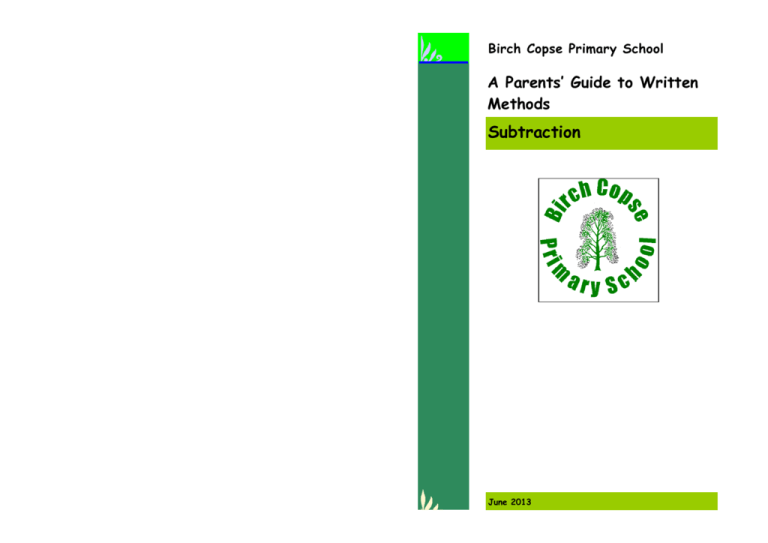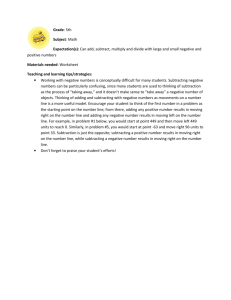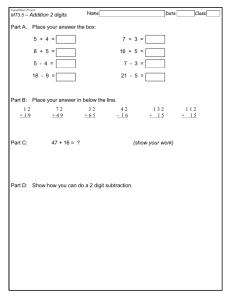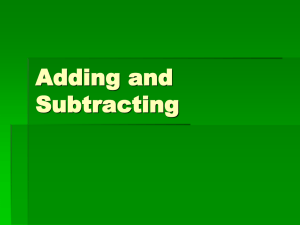Subtraction - Birch Copse Primary School
advertisement

Birch Copse Primary School A Parents’ Guide to Written Methods Subtraction June 2013 Subtracting numbers with decimals that do not have the same amount of decimal places. Aims of this Booklet. This booklet aims to provide an outline of the written and mental methods that are taught in mathematics at Birch Copse Primary School. Remember: • Line up decimal points. • Use a ‘dotted zero’ as a place holder (if needed). The methods show progression from Foundation Stage to level 6. Each year group may cover more than one method within class ensuring that children are taught according to their needs. The methods shown here are taught to not only enable children to answer calculations but to also solve mathematical problems. We consider the using and applying of these skills critical to progressing in mathematics. Subtracting numbers where ‘stealing’ from multiple columns is needed. Remember to use the vocabulary ‘number sentence’ OR ‘calculation’ instead of ‘sum’. Sum means add not calculation. Remember: • You can only ‘steal’ directly from the column to the left each time. • See tips from the opposite example, Mental strategies to support written methods for subtraction. This list is progressive but any appropriate method may be used within a level. • Counting back in 1s (5, 4, 3, 2, 1) Knowing 1 less (between numbers 1 to 10) (1 less than • 9 is 8) • • • Subtraction facts to 10 (10-3 = 7 10-4=6 etc) 1 less than a given number (1 less than 24 is 23) 10 less than a given number (10 less than 45 is 35) Page 2 Level 6 To use written methods as in level 5. children must be able to subtract any integer or decimal from another. Page 15 • Level 5 • Halves of numbers to 10 (Half of 8 is 4) Use objects to take away an amount (I have 20 marbles and take away 3 marbles, I have 17 left) At level 5 the children can use all four operations with decimals to two places. E.g. subtract numbers that do not have the same number of decimal places • • Subtraction facts to 20 (20-1=19 20-2=18) Count back in 2s, 5s, 10s (44, 42, 40; 65 60 55 50; 50, 40, 30, 20) • • Written method examples and explanation: Halves of numbers 1-20 (Half of 16 is 8) Subtracting a multiple of 10 from any number (36—20= 16, 145-30= 115) • Subtracting using 4 and 3 digit numbers. (Where ‘double’ carrying is needed) Know 1 or 10 less than a given number (1 less than 67 is 66; 1 less than 145 is 144; 10 less than 89 is 79; 10 less than 189 is 179) • Taking away 9 and 11 by subtracting 10 and adjusting (So 57- 11…. Do 57—10 is 56 then take away one more 55 or 63-9… Do 63-10 is 53 then add 1 which is 54) • • Subtraction facts to 100 (100-90 = 10 100-75=25) Subtracting any near multiple of 10 then adjusting. (335 –19… so do 335-20 which is 315 then add 1 to make 316) • Remember: • See tips from previous example. • Most helpful tip is remembering you can only steal from the column on the left directly next to the digit. • When stealing from a column that has a ‘zero’ in it (in this example there are zero hundreds.) So,,, looking at the tens column... 1 —3 (We need to steal, as this equals a negative number) We can’t steal from the hundreds column so we steal one (meaning one thousand) from the thousands to the hundreds column. We now have ‘ten’ in the hundred column . Now we can steal from the hundreds column to the tens column. Page 14 Subtraction facts to 1000 (1000—700 = 300, 1000—250=750) • Estimating using approximations. 315 - 213 = ? using knowledge of rounding so… 320-210 = 110 This will give an approximate answer Page 3 Subtracting decimals with two decimal places Early Learning Goals Remember: • Place the digits in the correct column. In this case, there 7 hundredths, so we put 7 in the hundredths column. • Line the decimal points up. In the Foundation Stage the children will: - show an understanding of the concept of taking away in free play - begin to include vocabulary involved in subtracting – respond to the vocabulary involved in subtraction rhymes and games - know that a group of things changes in quantity when something is taken away Subtracting decimals with two decimal places that involves ‘double’ stealing’ Written method examples and explanation: Subtraction in the Early Learning Goals is taught through play based opportunities and practical activities. The children use a set of objects, some of which are ‘taken away’. The vocabulary of subtraction is used during the activity so that children gain an understanding of how it is used and what it means. Here are some examples of practical activities. Page 4 Remember: • An important tip to remember is that we can only steal from the next column. E.g: 4– 9 (This will leave a negative number, so we have to steal from the next column to the left). We take one (meaning one unit) from the unit column and put it in the tenths column. We then say 14– 9 = (At this stage children should be aware of place value, so will know that really this is 1.4—0.9, we say 14– 9 to make it easier). • Once we have calculate this column we move onto the next, 1—7 again we need to steal. So we steal one (meaning one ten) from the tens column. We now have 11—7. This step is then repeated. • When we double steal it is really important that we cross the ‘old’ digit through once stolen so we can see clearly the digit that is left. Page 13 Level 4 “I have got 8 apples, but the dinosaur comes along and takes away 3, how many do I have left?” At level 4, the children can use efficient written methods of subtraction including decimal numbers. Written method examples and explanation: Subtracting 4 and 3 digit numbers. (Where no ‘double’ carrying is needed) Remember: • Subtract from the right. So here the units first. 3—8 - this will give a minus answers, so we say that we need to ‘steal from the next column’ We can only steal from the column to the left. In this case we steal one ten from the tens column. We say steal ‘one’ (meaning one ten) from the tens column’ We can now calculate 13—8 = 5. Continue with the digits in the next column to the left, in this 7—5 = • Use the word ‘steal to explain transfer of digits from one column to another • Be consistent with language, use single digit terminology e.g. 7– 5 rather than 70-50. Ensure children understand value of digits. Page 12 “Here are 2 bags of marbles. This one has got 6 marbles in. This one has got one less. How many in this bag?” Page 5 Level 1 At level 1, the children should be able to record their work, using pictures or diagrams and start to write — and = in their number sentences. Remember: • Subtract from the right. So in this case, subtract the units first. • Use the word ‘steal’ to explain transfer of digits from one column to another • Be consistent with language (e.g.units, tens, subtract, minus) • Partition numbers at side to help show the value of each digit. Written method examples and explanation: At level 1, the children will continue to use a variety of practical resources (counters, animals, flowers etc) to work out subtraction problems using numbers to 20.They will begin to write their number sentences alongside using objects to find the answers. For example, there were 10 gingerbread men and 4 got eaten by a dog, how many were left? Subtracting 3 digit numbers using column subtraction, where ‘stealing’ is needed. Subtracting decimals where stealing is not necessary. 10 — 4 = 6 The children will start by having all the gingerbread men then removing 4 and counting how many are left to find the answer. Page 6 Page 11 The children will then move on to subtracting a 2 digit number from another 2 digit number. To do this, the children will use a number line. The units are subtracted first, followed by the tens. They will then move on to writing a number sentence, drawing objects and crossing them out to find the answer. Moving on from Level 2 to Level 3 When moving on from level 2, the children will start calculating using 3 digit numbers. For example, 236—22 = They would calculate this using the numberline, as above, writing the 3 digit number at the end of the number line, subtracting the units, then the tens. The tens can be subtracted in jumps of 10, or larger jumps of other multiples of 10. Once, the children understand the concept of taking away objects, they will move on to using a number line to find the answer to subtraction problems by counting back. Level 3 At level 3, the children can subtract 3 digit numbers using a written method. Their calculations include ‘carrying’ and subtracting decimals (in the context of money). Written method examples and explanation: Subtracting 3 digit numbers using column subtraction, where ‘stealing’ is not needed. The children start at 10 and do 3 ‘jumps’ back to find the answer. Page 10 Page 7 Once the children are secure in using this method to subtract, they will begin to calculate subtraction, using column subtraction, where ‘stealing’ is needed as shown below. Level 2 At level 2, the children should be able to record their work in writing by writing a number sentence, e.g. 25—13 = 12 Written method examples and explanation: The children start by subtracting a 1 digit number from a 2 digit number. They solve this by using a 100 square to count back on. E.g. 25—3 = 22 Start at 25 and ‘jump back’ 3. The number that you land on is the answer. The children also use the 100 square for subtracting a 2 digit number. E.g. 45—21 = by counting back in ones first to subtract the units, then tens to subtract the tens. They also learn to record subtractions using a number line. They start calculating at the opposite end of the number line to addition as they are counting back. For example; If the 1 digit number being taken away is greater than the units of the 2 digit number, it will be recorded like this. The children then progress on to learning a written method for subtraction. This example shows subtracting 2 digit numbers using column subtraction, where ‘stealing’ is not needed. Page 8 The children will subtract the 8 by splitting it. They take away what they need to get to the ‘tens number’, then take away what is left. In the example above, the children would take away 5 first to get to 20. Then take away 3. Page 9






